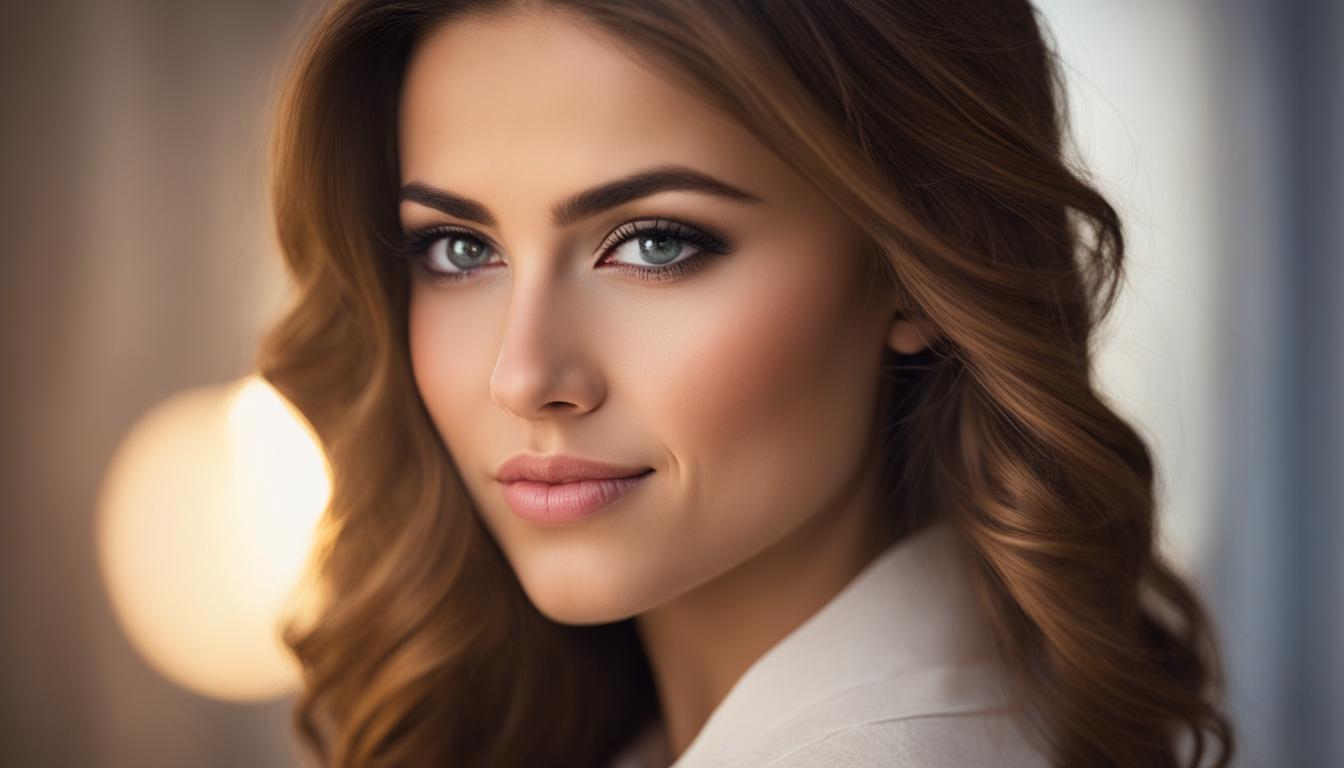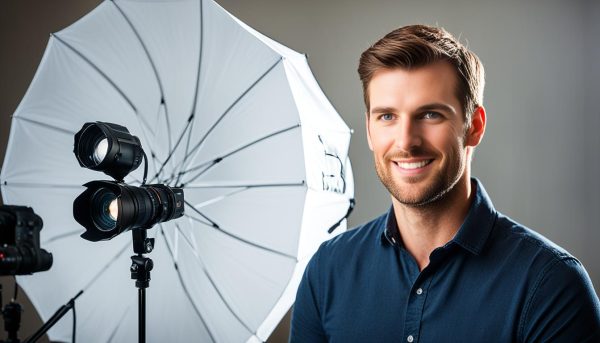If you’re looking to elevate your people photography to the next level, mastering the art of portrait perfection is a must. Capturing captivating portraits takes more than just a click of a button – it requires understanding and utilizing various techniques to achieve stunning results.
In this article, we’ll delve into the techniques and skills needed to create captivating portraits. From lighting and posing to capturing candid moments, we’ll cover it all. By utilizing these techniques, you’ll be able to create portraits that truly capture the essence of your subject.
Key Takeaways:
- Portrait perfection requires mastering various techniques.
- Lighting, posing, and composition are key elements in people photography.
- Capturing candid moments and authenticity adds depth to portraits.
- Experimenting with creative techniques and perspectives can add uniqueness to your portraits.
- Consistent practice and refinement of techniques are necessary to achieve portrait perfection.
Understanding Lighting in Portrait Photography
Lighting is one of the most important elements in portrait photography. It can make or break a photo, affecting mood, tone, and overall quality. In this section, you will learn about different lighting techniques and how they can be used to enhance your portrait photography.
Natural Light
Working with natural light can create stunning portraits, especially during the golden hour (the hour before sunset and after sunrise) when the light is warm and soft. It can be used to create dramatic silhouettes or add depth to your photos. However, it can also be unpredictable, so it’s essential to pay attention to the direction and quality of light to achieve the desired effect.
Studio Lighting
Studio lighting provides complete control over the lighting conditions and allows for consistent results. It can create a clean, polished look and is ideal for high-end fashion or beauty photography. However, it can be costly and requires technical expertise to handle the equipment.
Flash Photography
Flash photography can be used to add a pop of light and freeze motion, making it ideal for capturing action or indoor events. It can also be used to balance natural light or create a dramatic effect. However, it requires careful positioning and may be harsh if not used correctly.
“Lighting can make or break a photo, affecting mood, tone, and overall quality.”
Understanding the different lighting techniques and how to use them can help you create stunning portraits that capture the essence of your subject. Experimenting with lighting and combining different techniques can lead to new and exciting results.
- Use natural light for warm, soft portraits.
- Studio lighting provides complete control for a polished look.
- Flash photography adds a pop of light and can freeze motion.
Remember to pay attention to the direction and quality of light to achieve the desired effect. With these techniques, you can elevate your portrait photography and capture captivating images that tell a story.
Posing and Composition Tips for Perfect Portraits
The way a subject is posed and positioned within a photograph can play a significant role in the success of a portrait. To create perfect portraits, photographers need to master the art of posing and composition. Here are some tips:
1. Use the Rule of Thirds
The rule of thirds is a fundamental principle of good composition. It involves dividing the image into thirds horizontally and vertically and positioning the subject off-center. This creates a more dynamic and visually engaging composition. The rule of thirds can be applied when shooting in both landscape and portrait orientation.
| Without the Rule of Thirds | With the Rule of Thirds |
|---|---|
2. Use Leading Lines
Leading lines are lines within the image that guide the viewer’s eye toward the subject. They can be used to create depth and draw attention to important elements within the image. Leading lines can be found in a variety of settings, such as roads, paths, and bridges, and can be used to create interesting and dynamic compositions.
3. Use Natural Frames
Natural frames are elements within the image that frame the subject, such as windows, doorways, and archways. They can add depth to the image and draw attention to the subject, creating a visually engaging composition.
“The way a subject is posed and positioned within a photograph can play a significant role in the success of a portrait.”
4. Use Foreground, Middle ground, and Background Elements
When composing an image, it’s important to consider the foreground, middle ground, and background elements. Adding elements to each of these areas can create a sense of depth and increase visual interest. For example, a subject in the foreground with an interesting background can create a visually engaging composition.
5. Pose Your Subject Comfortably
The way a subject is posed can impact their comfort level and the overall success of the portrait. It’s important to communicate with your subject and make them feel comfortable in their pose. Be sure to direct their posture, but also encourage them to move and shift their weight to create a natural and relaxed appearance.
6. Use Props to Enhance the Composition
Props can be used to enhance the composition of a portrait and add visual interest. However, it’s important not to let the prop distract from the subject. When using props, ensure they are relevant to the subject and the overall story being told in the image.
- Use props to create a visual narrative or add depth to the image.
- Avoid using props that are irrelevant or distracting.
- Make sure the prop doesn’t obscure the subject’s face or body.
By mastering the techniques of posing and composition, photographers can create perfect portraits that are visually engaging and captivating to viewers.
Mastering Facial Expressions and Emotions
In people photography, capturing authentic facial expressions and emotions is key to creating captivating and memorable portraits. Here are some tips to help you master this skill:
Make Your Subject Feel Comfortable
One of the most important things you can do to capture genuine expressions is to make your subject feel at ease. Engage in conversation, crack a joke, or share a funny story to loosen them up. A relaxed subject is more likely to show their true emotions than one who is tense or nervous.
Evoke Emotions
As a photographer, you have the power to evoke emotions in your subject. Depending on the mood you want to create, consider playing music or giving your subject specific prompts to elicit a particular feeling. For example, if you want your subject to look pensive, ask them to think about something that makes them reflective.
Capture Authentic Moments
Authenticity is key when it comes to capturing genuine, emotive expressions. Look for candid moments when your subject is not actively posing for the camera. These moments can be fleeting, so be ready to capture them quickly.
| Tip | Description |
|---|---|
| Focus on the Eyes | The eyes are the windows to the soul, so focus on your subject’s eyes to capture their true emotions. |
| Experiment with Angles | Playing with angles can help create unique and dramatic portraits that showcase a subject’s emotions in a more impactful way. |
| Use Your Surroundings | The environment around your subject can also play a role in capturing their emotions. Use the surroundings to create a narrative that complements your subject’s expressions. |
By following these tips, you can master the art of capturing authentic facial expressions and emotions in your portrait photography. Remember to practice and experiment with different techniques to refine your skills and achieve portrait perfection.
Choosing the Right Backgrounds and Props
When it comes to people photography, selecting the right backgrounds and props can make all the difference in creating captivating portraits. The background and props work together to enhance the mood, story, and overall aesthetic of the image.
Backgrounds
The right background can complement the subject, add depth to the image, and create a cohesive visual narrative. When selecting a background, consider the subject’s outfit, skin tone, and personal style. If the subject is wearing a bold patterned outfit, choose a neutral or solid color background to avoid clashing. If the subject has fair skin, opt for a darker background to create contrast.
Another important factor to consider is the location. Shooting outdoors provides a variety of natural backdrops, such as parks, streets, and beachscapes, while shooting indoors allows for more controlled environments, such as studios or home settings.
Table: Background Suggestions
| Subject | Background |
|---|---|
| Babies | Blankets, textured fabrics |
| Children | Playgrounds, nature, colorful walls |
| Teens | Urban areas, graffiti walls, industrial settings |
| Adults | Nature, urban areas, solid color walls |
Props
Props can add a personal touch to portraits and help tell a story. They can be anything from a favorite book or instrument to balloons or flowers. When choosing props, consider the subject’s hobbies, interests, and personality.
- Pets
- Instruments
- Hats
- Books
- Flowers
When used thoughtfully, backgrounds and props can take a portrait from ordinary to extraordinary. The key is to choose elements that complement the subject, tell a story, and add to the overall narrative.
The Power of Post-Processing in Portrait Photography
Post-processing is an essential step in perfecting your portrait photography. It allows you to refine and enhance your images in ways not possible with just the camera alone.
Why post-process your portraits?
Post-processing enables you to adjust exposure, contrast, color saturation, and sharpness to achieve a more polished look. It also allows you to remove unwanted distractions or blemishes to create a flawless finish.
Popular post-processing software
There are many software options available for post-processing, but some of the most popular ones include Adobe Photoshop and Lightroom, Capture One, and Skylum Luminar. These software options provide a wide range of tools and features to help you refine your portraits.
| Software | Pros | Cons |
|---|---|---|
| Adobe Photoshop | Advanced editing tools and features | Steep learning curve |
| Adobe Lightroom | User-friendly interface and presets | Limited editing capabilities |
| Capture One | High-quality color correction tools | Expensive |
| Skylum Luminar | AI-powered editing tools for quick and easy adjustments | Limited advanced editing options |
Tips for post-processing portraits
- Start with global adjustments, such as exposure and white balance
- Use local adjustments to tweak specific areas of the image, such as eyes or skin
- Use layer masks to apply adjustments selectively
- Avoid over-editing, which can result in unnatural looking images
Utilizing post-processing techniques can help you achieve a cohesive, captivating style in your portrait photography. Experiment with different software and techniques to find what works best for you and your unique style.
Working with Natural Light for Stunning Portraits
When it comes to people photography, lighting can make all the difference. Natural light, in particular, can create stunning portraits that are both captivating and authentic. By understanding how to work with natural light, photographers can elevate their portraits to the next level.
One of the most important things to consider when working with natural light is the time of day. The golden hour, which occurs during the first and last hours of sunlight, provides a soft, warm light that can add a beautiful glow to portraits. However, this window of time is short, so it’s important to plan ahead and be ready to capture the perfect shot.
Another factor to consider is the quality of light. Direct sunlight can create harsh shadows and unflattering highlights, so it’s important to find shaded areas or diffuse the light. One way to diffuse sunlight is by using a reflector, which can bounce the light back onto the subject and create a more even illumination.
Understanding the direction of light is also key. Backlighting, where the sunlight is behind the subject, can create a stunning halo effect and add depth to the portrait. Side lighting, where the light hits the subject from the side, can create dramatic shadows and highlights, adding a sense of mood and emotion to the image.
As with any type of photography, it’s important to experiment and find what works best for each specific situation. Don’t be afraid to try new things and see what kind of results you can achieve. With these tips in mind, working with natural light can be a powerful tool in creating stunning portraits.
Directing and Communicating with Your Subjects
Directing and communicating with your subjects is a critical aspect of portrait photography. The ability to build a rapport with your subjects and give clear instructions can make the difference between an average portrait and a captivating one.
To direct your subjects effectively, start by establishing a comfortable and welcoming atmosphere. Take the time to get to know your subjects and find common ground to build rapport. This will help them feel more relaxed and open to your suggestions.
When giving instructions, be clear and concise. Avoid using photography jargon or technical terms that your subjects may not understand. Instead, use simple and straightforward language to communicate your vision and desired outcome.
Encourage your subjects to ask questions and share their own ideas. This can lead to unexpected and creative shots that capture their unique personalities and characteristics.
“Directing your subjects is like steering a ship. You need to know where you’re headed, but you also need to be adaptable and willing to make adjustments along the way.”
Remember that directing and communicating with your subjects is a collaborative process. Be open to feedback and willing to modify your approach as needed. This can lead to a more enjoyable and successful portrait session for both you and your subjects.
The Art of Posture and Body Language
Posture and body language play a crucial role in portraying your subjects in the best possible light in people photography. It is essential to understand their significance and how to utilize them for creating captivating portraits.
First and foremost, it’s important to make your subjects feel comfortable and at ease. Encourage them to relax their shoulders and stand up straight. A good posture not only looks aesthetically pleasing but also helps to create a positive impression on the viewer.
Another crucial element is body language. It’s essential to communicate the right message through your subject’s body language. When shooting portraits, focus on the eyes, facial expressions, and hand gestures, as they can convey a lot of emotions. Ask your subjects to tilt their head slightly, look into the camera, or glance at something off-camera to create a natural and engaging pose.
Another posture tip is to try different angles and perspectives, depending on the subject and the mood you want to convey. For example, ask your subject to lean against a wall or use props to create a dynamic composition. Experiment with posing your subject sitting down or lying down to give a more relaxed and casual feel to the image.
| Posture and Body Language Tips | Example Image |
|---|---|
| Encourage your subjects to stand up straight and relax their shoulders. | |
| Focus on the eyes, facial expressions, and hand gestures, as they can convey a lot of emotions. | |
| Try different angles and perspectives to create a dynamic composition. |
Ultimately, mastering the art of posture and body language takes time and practice. By focusing on these essential elements, photographers can create visually pleasing, engaging, and authentic portraits that capture the essence of their subjects.
Capturing Candid Moments and Authenticity
In people photography, capturing candid moments and authenticity is key to creating visually captivating portraits that evoke emotions and tell a story. While posed portraits have their place, candid shots can add depth and portray subjects in a more natural and honest light.
One way to capture candid moments is to remain unobtrusive and let the subjects carry on with their activities without interrupting. This allows genuine interactions and emotions to unfold organically, leading to unscripted moments that can be incredibly powerful and emotionally resonant.
Another technique for capturing candid moments is to use a long telephoto lens, which allows photographers to zoom in from a distance and capture candid expressions and interactions without being noticed. This is especially useful for events such as weddings or parties, where subjects may be too busy to pose for traditional portraits.
Authenticity is another crucial aspect of candid photography. To achieve this, photographers should aim to build a rapport with their subjects and make them feel comfortable in front of the camera. This can be achieved by engaging in conversation, breaking the ice, and getting to know the subject’s personality and interests.
Finally, it’s important to be patient and observant, waiting for the right moment to capture the perfect shot. This may require taking multiple shots and waiting for the right facial expression or body language to appear. Patience and perseverance can lead to breathtakingly authentic portraits that will stand the test of time.
Experimenting with Creative Techniques and Perspectives
As a photographer, it’s essential to experiment with creative techniques and perspectives to add a unique touch to your portraits. While there are traditional methods that produce stunning results, sometimes you need to try something unconventional to develop your style and stand out from the crowd.
One creative technique that you can experiment with is using a prism to refract light and create eye-catching, abstract effects in your portraits. To achieve this, hold a prism in front of your lens and move it around until you’re satisfied with the result.
Another creative tool that photographers often overlook is the use of multiple exposures. This technique involves combining two or more images into one to produce a unique and visually appealing portrait. It’s particularly effective when you want to capture different perspectives of your subject in a single image.
When it comes to perspective, there are many ways to experiment. One popular technique is shooting from a low angle to create a sense of height and power in your subject. Alternatively, you can experiment with a high angle, shooting down on your subject to create a more vulnerable or submissive look.
Overall, experimenting with creative techniques and perspectives can help you develop a unique style and create captivating portraits. Don’t be afraid to try new things and push the boundaries of traditional photography.
Conclusion
Portrait perfection requires a combination of technical skill, creative vision, and effective communication with your subjects. By understanding the significance of lighting, posing, composition, and capturing authentic emotions, you can elevate your portraits to the next level. Choosing the right backgrounds and props, experimenting with creative techniques and perspectives, and harnessing the power of natural light can help you create stunning and unique images.
Continuous Practice and Refinement
Remember, there is always room for improvement, and continuous practice and refinement is key to achieving portrait perfection. Take the time to study the work of other photographers, attend workshops and webinars, and experiment with new techniques. With dedication and persistence, you can hone your skills and create portraits that captivate and inspire.
Your Journey to Portrait Perfection
We hope that this article has provided you with valuable insights and techniques to help you on your journey to achieving portrait perfection in people photography. Remember to always be patient, stay positive, and most importantly, have fun! Happy shooting!
FAQ
What is portrait perfection?
Portrait perfection refers to capturing captivating and visually appealing portraits in people photography. It involves mastering various techniques such as lighting, posing, composition, and capturing genuine emotions to create stunning and impactful images.
Why is lighting important in portrait photography?
Lighting plays a crucial role in portrait photography as it helps to shape and highlight the subject’s features, create mood and atmosphere, and add depth and dimension to the image. Understanding different lighting techniques, such as natural light, studio lighting, and flash photography, can significantly enhance the overall quality of the portraits.
How can I pose my subjects effectively?
Posing is a key aspect of capturing perfect portraits. To pose your subjects effectively, consider their body language, facial expressions, and the overall composition of the image. It’s important to make your subjects feel comfortable and guide them to achieve natural and flattering poses.
How can I capture genuine emotions in my portraits?
To capture genuine emotions in your portraits, it’s essential to establish a rapport with your subjects and create a relaxed and comfortable environment. Encourage them to express themselves naturally and prompt them with meaningful interactions or thoughts. Being patient and observant will help you capture authentic moments that evoke emotions.
What role do backgrounds and props play in portrait photography?
Backgrounds and props can greatly enhance the visual impact of your portraits. It’s important to choose backgrounds that complement the subject and create a cohesive narrative. Props can also add depth and interest to the image, helping to tell a story or convey a particular theme or mood.
How does post-processing contribute to portrait photography?
Post-processing allows photographers to refine their portraits, enhance the overall quality, and create a consistent style. Popular editing techniques include adjusting exposure and color balance, retouching skin, and applying creative filters. Software such as Adobe Lightroom and Photoshop are commonly used for post-processing.
What are some tips for working with natural light in portrait photography?
Working with natural light requires understanding different lighting conditions and how they can impact your portraits. It’s important to utilize different times of the day, such as golden hour or blue hour, to achieve unique lighting effects. Modifying natural light using reflectors or diffusers can also help you achieve desired results.
How can I effectively direct and communicate with my subjects?
Building a rapport with your subjects is crucial for effective communication. Make them feel comfortable and establish clear communication by providing specific instructions and feedback. Be open to their ideas and suggestions, and give them space to express themselves naturally. Remember, effective communication leads to more authentic and captivating portraits.
What is the significance of posture and body language in portrait photography?
Posture and body language can greatly influence how subjects are portrayed in portraits. It’s important to pay attention to the subject’s posture, angles, and gestures to create a visually pleasing and engaging composition. Utilize body language to convey emotions and create dynamic and impactful images.
How can I capture candid moments and authenticity in my portraits?
Capturing candid moments and authenticity requires being observant and ready to capture spontaneous interactions and expressions. Create a relaxed and comfortable environment for your subjects, and allow them to be themselves. Avoid directing or interrupting the natural flow of the moment, as it’s often in these unscripted instances that true emotions shine through.
How can I add uniqueness to my portraits through creative techniques and perspectives?
Experimentation is key when it comes to adding uniqueness to your portraits. Try different angles, lens choices, and creative compositions to bring a fresh perspective to your images. Don’t be afraid to think outside the box and explore unconventional techniques that showcase your personal style and creativity.






